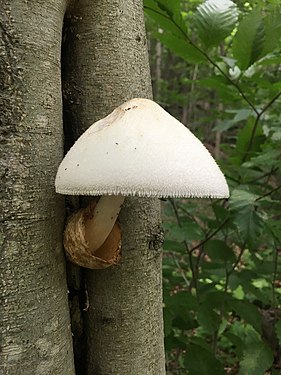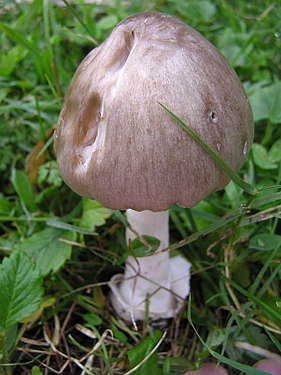

In mycology, a volva is a cup-like structure at the base of a mushroom that is a remnant of the universal veil, or the remains of the peridium that encloses the immature fruit bodies of gasteroid fungi. This macrofeature is important in wild mushroom identification because it is an easily observed, taxonomically significant feature that frequently signifies a member of Amanitaceae. This has particular importance due to the disproportionately high number of deadly poisonous species contained within that family.
A mushroom's volva is often partially or completely buried in the ground, and therefore care must be taken to check for its presence when identifying mushrooms. Cutting or pulling mushrooms and attempting to identify them later without having noted this feature could be a fatal error.
Whilst a volva is a feature best known from Amanita species and stinkhorns such as the Phallaceae family and others in the Phallales order, it may also occur with other genera including:
Some other species such as Leucoagaricus volvatus, Leucoagaricus bivelatus also display a volva despite this not being a typical trait for these genera.
The majority of the almost 300 species described In the Conocybe genus do not have a volva but there are a small number of species in Conocybe section Singerella which possess a small volva, though in some it may not be immediately evident as they can remain buried in dung. Conocybe species with a volva include: C. anthuriae, C. corneri, C hornana, C. locellina, C. vaginata, C. volvata, C. volviornata, C. volviradicata.
-
 Volvariella bombycina
Volvariella bombycina
-
 Volvariella surrecta growing parasitically
Volvariella surrecta growing parasitically
-
 Volvopluteus gloiocephalus
Volvopluteus gloiocephalus
See also
References
- Kirk PM, Cannon PF, Minter DW, Stalpers JA (2008). Dictionary of the Fungi (10th ed.). Wallingford, UK: CAB International. p. 727. ISBN 978-0-85199-826-8.
- Miller HR, Miller OK (1988). Gasteromycetes: Morphological and Developmental Features, with Keys to the Orders, Families, and Genera. Eureka, California: Mad River Press. p. 133. ISBN 0-916422-74-7.
- Kuo M. (2007). 100 Edible Mushrooms. Ann Arbor, Michigan: The University of Michigan Press. p. 45. ISBN 978-0-472-03126-9.
- Akers, Brian P.; Ovrebo, Clark L. (2005). "Leucoagaricus bivelatus, a new volvate leptoid species". Mycotaxon. 91: 303–308.
- ^ Watling, Roy; Hausknecht, Anton (1997). "Conocybe anthuriae, a new volvate species from Mauritius (Africa)" (PDF). Österreichische Zeitschrift für Pilzkunde. 6.
- Watling, Roy (1979). "Observations on the Bolbitiaceae XVII Volvate Species of Conocybe" (PDF). Sydowia Beihefte. 8: 401–415.
- Watling, Roy (1979). "Observations on the Bolbitiaceae XVII Volvate Species of Conocybe" (PDF). Sydowia Beihefte. 8: 401–415.
- Agretious Thomas, K.; Hausknecht, Anton; Manimohan, P. (2001). "Bolbitiaceae of Kerala State, India: New species and new and noteworthy records" (PDF). Österreichische Zeitschrift für Pilzkunde. 10: 87–114.
- Horak, Egon; Hausknecht, Anton; Desjardin, Dennis E. (2002). "Notes on extra-European taxa of Bolbitiaceae (Agaricales, Basidiomycota)" (PDF). Österreichische Zeitschrift für Pilzkunde. 11: 226.
- Watling, Roy; Işiloğlu, Mustafa; Sermenli, Hayrünisa Baş (2011-02-11). "Observations on the Bolbitiaceae 31. Conocybe volviradicata sp. nov". Mycotaxon. 114 (1): 145–149. doi:10.5248/114.145.